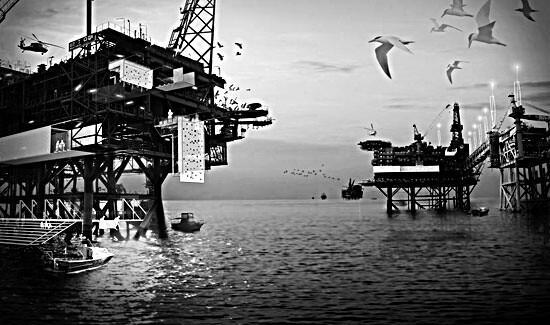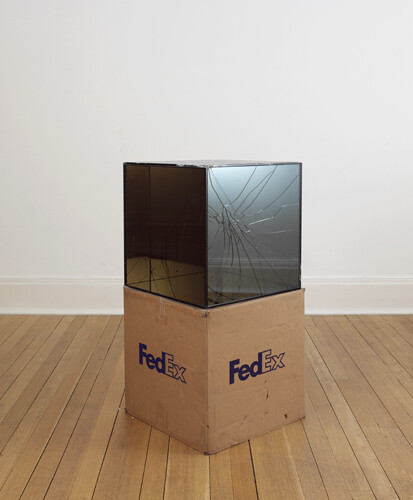For capitalism to sustain itself, to reproduce indefinitely, it needs to incrementally gobble up more and more. It must continually overturn any balanced cycles, as they can lead to stagnation and lost opportunities for growth. Extinctions are drawn to it like filaments to a magnet. The imperative to grow and the need for unrestricted license to devastate are two sides of the same coin—not only mutually dependent but structurally essential. Yet, however deplorable, growth and devastation can be aesthetically generative: they set us on a course toward imagining what the world will look like as it slides toward the inorganic.
By constantly invading and liquidating resource-rich contexts, capitalism encourages images that project what will inevitably be left in its wake: a dead world. And just as one can imagine (or see) patches of devastated and desolate land, a kind of localized post-extraction desertification, one can just as easily imagine this becoming a planetary condition: the globe as a rotating, dead lithosphere, coated in a fine dust of decomposing once-organic particles. Individual patches of dead world synthesized into a continuous crust.


1. Grey Goo
In 1986, Dr. K. Eric Drexler, at the time a Research Affiliate at MIT’s Artificial Intelligence Laboratory, published Engines of Creation, a book celebrating the growing productive capabilities of nanotechnology and the coming age of mechanochemical manufacturing. He was preparing us for the “assembler breakthrough”—the moment when self-replicating machines as small as molecules would become the driving engines of contemporary technology. Like science fiction, it was a testament of—or from—the future. It came in a warm language of affirmation and delight: a less arduous life was guaranteed by the inevitable emergence of molecular technology. We were moving up, pushing forward, relieving ourselves of unseemly burdens such as those of aging and dying or having to work for a living. But in one chapter in the book—Chapter 11, “Engines of Destruction”—Drexler slips out of character and offers a simple and formal warning, one with enough seductive charge and narrative potential to take on a life of its own:
The early transistorized computers soon beat the most advanced vacuum-tube computers because they were based on superior devices. For the same reason, early assembler-based replicators could beat the most advanced modern organisms. “Plants” with “leaves” no more efficient than today’s solar cells could out-compete real plants, crowding the biosphere with an inedible foliage. Tough omnivorous “bacteria” could out-compete real bacteria: they could spread like blowing pollen, replicate swiftly, and reduce the biosphere to dust in a matter of days. Dangerous replicators could easily be too tough, small, and rapidly spreading to stop—at least if we make no preparation. We have trouble enough controlling viruses and fruit flies.1
In the wake of Drexler’s book, the threat related in this paragraph became popularized as the “grey goo problem.” It was abhorred in nanotechnology circles, but among science fiction writers and aficionados, it was fashionable and much-loved. The tale, in a more developed stage, involves a swarm of self-replicating, biovorous nano-assemblers run amok. If what it relates was to actually occur, it would be the first and only environmental disaster caused by the field of molecular mechanochemical manufacturing, with a total consumption of the planet taking place in as little as ~104 seconds after the chain of reproduction was first triggered.2 Either by mimicking biological replicators like bacteria, but aborting or overstepping the boundaries of their intended use (in the sci-fi version), or by being produced in a lab with the capacity to function autonomously (in the scientist’s hypothetical version), these molecule-sized machines multiply exponentially by transferring “genetic” algorithms to new units and using our biosphere as fuel. They reproduce until they ingest all life on the planet and leave behind a desolate landscape of grey slime. “Ecophagic nanorobots would regard living things as environmental carbon accumulators and biomass as a valuable ore to be mined for carbon and energy,” writes Robert A. Freitas Jr. “Of course, biosystems from which all carbon has been extracted can no longer be alive but would instead become lifeless chemical sludge.”3
The world ends, then, as a dead, undifferentiated, slimy surface—a massive lithosphere covered in lifeless sludge and nanomass wreckage. The scenario is one of mass, if unintentional, “species” suicide (the replibots) and full biological elimination, fated by the meeting of machines programmed for infinite non-mutational reproduction and an environment with finite energy-producing resources. One ecology doesn’t emerge by eating and metabolizing another—an affirmationist escape hatch available to certain flinching strands of apocalyptic sci-fi. This isn’t a machines-take-over story. These replibots eat the environment for no reason but to proliferate more replibots, unaffected by the useless grey goo they generate and the acceleration of their own demise. This isn’t the production of a new world, but a sped-up, unintentional dissolution of the existing one. One world isn’t being transfigured into another; rather, a world is being transfigured into a non-world, dissolved into inorganic slime.
Articles challenging this grey goo scenario quickly appeared, multiplying exponentially like the replibots they targeted. This was hardly surprising. Dependent on large public research grants and seeking application in the private manufacturing sector, the field of nanotechnology quickly deployed its reactive forces. The last thing it needed to contend with was an unsubstantiated speculative doomsday scenario. Drexler himself was at the forefront of efforts to argue that his scenario is highly unlikely and that advances in safety since he wrote his book render it all but impossible.


In the end, the mythological space opened by his gleeful slip into the apocalyptic needed to be fenced off and eradicated. As Drexler explicitly stated in his book—giving us a furtive glance at the economic imperative that guides the project of molecular technology—the market is the “ultimate test.” And we all know that a capricious market may suddenly recoil from this sort of risk (even if not from others, as we’ve come to learn lately), particularly where long-term and high-investment projects that involve untested technologies are concerned. But what is interesting, beyond considering just how irreversibly bound science and the market are, is attempting to explain why this grey goo scenario found such a warm reception beyond cloistered nanotechnology circles, in the culture it was thought to abolish. Why does the scenario still have currency as narrative, while having been completely debunked as hard science? For what amorphous, slippery collective feeling does this scenario serve as an outlet or allegory?
2. The Deeper Cut
The pages that precede the introduction of the grey goo problem in Drexler’s book are concerned with the eliminations that will accompany the proliferation of assembler-based replicators and thinking machines. He mentions specifically the elimination of global trade (automated engineering can be localized and shrunk), the elimination of the current parameters of human mortality (the indefinite extension of life through artificial cell-reparation mechanisms), the elimination of human labor due to near absolute automation (replicators producing objects, as well as other replicators to replace and upgrade themselves). All these positively-charged eliminations, however, are secondary to the most terrifying potential consequence of nanotechnology gone awry: the abolition of life, the wholesale destruction of the biological.
Beyond whatever kind of warning the grey goo problem presents in relation to the real advances of nanotechnology, it allegorizes eliminative threats to life that nevertheless exist in other spheres. It absorbs threats that we may not be able to deal with directly, threats that need to be displaced in order to keep them from cutting a gash in our symbolic order—threats that are too uncomfortable, that indict us too shamefully, that demand too much of us in terms of altering our way of life to encourage anything but displacement or concealment. The cut is too deep. The notion that Drexler’s apocalyptic scenario recodes a different, already active process of elimination seems a particularly plausible explanation considering the implausibility of the grey goo threat, according to the very scientist who originally posed the problem.


One of the things that the grey goo problem may stage is the very dissipative tendency that is at the core of capitalist production itself—the movement toward resource elimination as the necessary correlation to the expansion of capital. Few would claim to be anything but appalled by capital’s dissipative compulsion, just as they would refuse to accept that such an impulse be naturalized as part of the intrinsic dynamic of rational economic development. The innocence that allows us to be hoodwinked in this way belongs to another time. The delusional character of a system predicated on the infinite growth can’t be smudged out of the picture so easily anymore. We know that such a system is not viable in the long run, that its predatory practices are indefensible, and yet on so many levels we continue to behave as though capitalism were a necessary and unshakeable system. It’s a fatality that we can at most resist through the subtraction of our subjective belief in it, which we often register in private gestures, at reduced scales, with “personal initiative” and demands for “corporate responsibility.” We participate, despite ourselves, in a consensual collective fantasy, frayed at its edges but holding, of plenitude and regeneration, of the miracle of the system’s unendingness, assailed on every side by apocalyptic fantasies but nowhere extinguished by them, ratifying the old Jamesonean/Žižekean quip that it is easier to imagine the end of the world than the end of capitalism. In fact, it is Žižek who never tires of reminding us that in our “post-ideological” world we participate fully in the capitalist game while simultaneously telling ourselves that we don’t believe in it at all. We disavow in thought and speech what we adhere to in action.
The naturalization of resource depletion, shielded as much as taxed by our disavowals, cannot help but affect cultural production. Sculpture, in its slouching toward interior design and décor—even if it does so in a reflexive, post-Broodthaersean mood— recognizes its complicated and diminished place in a world where nearly all object production and experience is geared toward commodified urban infrastructure. This reduced ambition anticipates the desertified landscapes to come of post-resource depletion.
Last year, design research collective InfraNet Lab/Lateral Office developed a series of speculative infrastructural projects.4 Among these was Re-Rigging, an ambitious proposal that sought to develop the offshore oil excavation infrastructure for the Caspian Sea, not yet marching at full speed due to post-1991 border and legal disputes but inevitably on its way nonetheless. The project seeks to render this infrastructure such that potentials embedded at the design stage can be actualized when the rigs eventually become derelict and are left behind (oil extraction has been given a very short lifespan there, hitting its peak between 2020 and 2030). After the oil is used up, the built structures would serve new functions as recreational sites, bird sanctuaries, and the like. What is astonishing in this is that the depletion of petroleum is naturalized as empirical fact—as if it had already happened—and design can only be relevant by factoring that into the process. This is the project’s pragmatic realism. A coming decimated landscape—the end point of a process so natural that it can be accounted for before it is even set in motion—becomes a determinant factor in the architectural production of the present.


While it is true that Infra Net/Lateral Office is proposing adaptive and reactive systems, laudably serving as counterpoints to the monological infrastructures of the twentieth century that end up as useless concrete carcasses, the first thing it adapts and reacts to is the will to dissipation that characterizes transnational capital. This translates into a kind of site or even geographical sensitivity: infrastructure is not only conceived to exploit one aspect or resource of a place—in this case, the products of the subsea geology—but as an interface between a multiplicity of elements, conditions, and populations. In the Caspian Sea, the infrastructure proposed by Infra Net/Lateral Office will look to intertwine the subsea, the activity in the sea (the need to sustain and enlarge the populations of sturgeon), and what happens in the air (the migratory patterns of birds which cut right over this body of water), while also building into the system the potential to recuperate the infrastructure after it can no longer serve its original purpose. The passive anticipation of uselessness that accompanied infrastructural building becomes active planning for post-depletion. It’s pre-emptive design for the inevitable. In order to curtail the possibility of having only abandoned infrastructure in the end, one has to think from the other side of devastation. Infra Net/Lateral Office explains it in the language of promotional brochures: “The Caspian Sea’s oil rig field is retrofitted for post-oil occupation by wildlife, maverick entrepreneurs, and adventure seekers.”5
Resource depletion, even if still in potentia, establishes “retrospectively” the horizon of possibility and necessity for current design. Inexistent, projected, the deserts to come are the regulative force that determines what will be produced. An architectural need is formulated in such a way that any call to curtail the progress of destruction is rendered romantic. This is the new normal, the way power is extracted from the only future that transnational capital proposes as conducive to its maintenance and growth. Like credit in the financial sphere, pre-emptive design objectifies the future before it even arrives. Pre-emptive design capitulates to an erosion of critical distance in order to vindicate itself as the pragmatic-ethical option: it is willing to look the bitter truth in the face and devise, in an unsentimental way, the best possible solution for the depletion to come. It doesn’t look ahead in order to imagine detours, to insert “retrospectively” counterfactual possibilities into our present. It stares down that romantic option and soberly and pragmatically accepts that the only agency possible is that of the hardboiled and sober social clairvoyant: she knows what’s coming, so the best she can do is hide tents and rafts and bottles of water in the houses that the hurricane will devastate. This is just a step removed from “the superstitious compulsion to make some gesture when we are observing a process over which we have no real influence.”6


3. Last Stop
When we speak of “post-Fordism,” “immaterial labor,” “cognitive capitalism,” “precarity,” and so forth, we are certainly speaking of the material conditions and effects of capitalism as it currently functions. However, these are its conditions as it explicitly relates to us. What if we attempt to take stock of it from a different vantage point? What if we read capitalism not as it manifests itself in relation to human bodies but as its destination reveals it to be: an Alien monstrosity, an insatiable Thing that appropriates the energy of everything it touches and, in the process, propels the world toward the inorganic? After all, aren’t depletion and dissolution its underlying logics, accompanying its rampant drive to growth, its myth of unending prosperity? Isn’t it consistently and egregiously dragging things—natural resources, ways of life, communal values, traditional forms of social organization, symbolic systems, laboring bodies, public spheres, social safety nets, self-sufficient economies, entire populations (animal and human), the destabilizing potential of formal innovation in aesthetic production, happiness—to their terminus point, either to complete annihilation or to subsumption under a logic of general equivalence? What if we propose that capitalism has something like agency and that this agency is manifested in ecophagic material practices? Capitalism eats the world. Whatever transformations it generates are just stages in its monstrous digestive process.
Surely this is what someone like Nick Land has in mind when he proposes that “the history of capitalism is an invasion from the future by an artificial intelligent space that must assemble itself entirely from the enemy’s resources.”7 It feeds on what it finds, leaving behind a metaphorical grey chemical sludge. This alien intelligence from the future seems committed to bringing about an ultimate inorganic state, the apocalypse of that final drag of everything into the post-biological, and it is working incrementally as it moves forward through history in order to realize the future it left “behind.” Like a swarm of replibots run amok, capitalism feeds on this world in order to swell itself, but maybe not to swell into anything more than an enlarged, raging version of itself—like a massive hurricane, all spinning forces looking to avoid any shoreline (political and economic alternatives) that may serves as a counterforce, chasing the conditions that will allow it to speed up and grow even more. And like the replibots, its own demise, too, may be announced in the devastation it leaves behind, but it counteracts this on at least two fronts: by generating myths of interplanetary travel and post-biological ‘life’ (the Singularity and so forth) and pushing technological unfolding down these roads; and by generating abstract financial instruments that allow it to “create value ex nihilo,” as Alex Williams argues:
What is necessary is to think the in-itself of capitalism outside of any correlation to the human … For surely what all analyses of capitalism have presumed to date is the capitalist “for-us” (construed in positive or negative terms), whereas capital is ultimately a machine which has almost no relation to humanity whatsoever, it intersects with us, it has us as moving parts, but it ultimately is not of or for-us. Capital properly thought is a vast inhuman form, a genuinely alien life form (in that it is entirely non-organic) of which we know all-too-little. A new investigation of this form must proceed precisely as an anti-anthropomorphic cartography, a study in alien finance, a Xenoeconomics … Marx’s labor theory of value fails to think the capitalist in-itself, the ability to create value ex nihilo (i.e., credit, and all financial instruments constructed from variations on this theme). For Marx credit, “virtual capital,” and speculation built upon it is “the highest form of madness.” Instead we ought to think of credit-based “virtual” capital as the highest form of capital. This is not a mere semantic shift, but rather a revolutionary inversion of the L[abor] T[heory of] V[alue], following Deleuze & Guattari in considering capitalism-as-process, conducted upon pre-existing social forms, disassembling and reassembling them to suit its own nefarious and presently obscure ends. As process rather than concrete “thing” we must consider its true nature to be contained in its destination, rather than the primitive building blocks from which it originally constituted itself (i.e., in the worlds of “virtual” capital rather than the alienation of human labor, which is surely merely an initial staging post).8
A split, at some point, is easy to imagine: capitalism continues to expand virtually, while the landscapes it once extracted resources from are left useless. The end of the world again, before the end of capitalism. The end of us. Granted some license, we can graft the slimed and dead world that the grey goo problem promises to an imaginary point at which capitalism has realized the goal inherent to its compulsion to deplete. It’s the look of its destination. As is always the case with allegory, it’s not that one scene replicates another, but that it recodes it in order to cast it in high-relief through imperfect but suggestive correspondences. One scene becomes a figural machine through which another one can be explained or approximated, particularly where direct representation is found wanting, where the stiff edges of verisimilitude prohibit accurate depiction, where bodies are asked to generate an understanding of their own abolishment.


4. Increased Velocity
Seeing as the ground has shifted beneath current cultural production, a question to consider is: What new options appear on the horizon for cultural production by opening an “inhuman” perspective on this grey goo capitalism? How do we do more than find the best compromise for a dissipative tendency that forcefully encodes itself in cultural objects, that works from the get-go to confiscate and annul divergent options to the kind of aesthetic artifacts that reinforce its naturalization?
Surely, there is the possibility of generating resistance, of finding new ways to counter the compulsion to expand at any cost, of articulating and producing or prefiguring new ways of living that challenge capitalism. In short, there is the possibility of refusing any perspective that puts us under erasure, that disregards a priori whatever participatory, resistant, transformational, insurrectionary, and emancipatory gestures we may still muster. There may be no need to undermine just yet what we may be able to accomplish, the ways in which we can still locate sites in which to intervene politically and/or where we can generate economic difference that challenges the logic and kinds of relations that capitalism allows, rendering visible practices that are currently discounted or repressed. This is what marks intelligent, politically infused cultural projects as relevant in a lifeworld no longer free of the tendency to absolute commodification and ruthless co-optation.
Not long ago, Franco Berardi wrote about one of the continuities between modernity and what has followed it: the idea of acceleration as an underlying principle. He proposes that, despite whatever changes characterize the social transition out of modernity, the drive to speed things up has survived the shift from the manufacturing sphere to the semiotic one. These days,
when the main tool for production ceases to be material labor and becomes cognitive labor, acceleration enters another phase, another dimension, because an increase in semiocapitalist productivity comes essentially from the acceleration of the info-sphere—the environment from which information arrives in your brain.9
As is always the case with Berardi, he is interested in how these things function in relation to the human body. His metric is always anthropocentric. He finds a crisis point where the production of semiotic goods exceeds, in speed of production and management of quantity, the human brain’s capacity for attention. For him, it is a question of processing time for the brain—or, rather, of the lack of this necessary time and the injunction to make things increasingly easier that follows this shortage. Everything must be easier, less meaningful, so that we can take in more of it, sacrificing robust experiences for the sake of mere informational ingestion. “More and more signs buy less and less meaning” as “our relationship to the world … become[s] purely functional, operational—probably faster, but precarious.”10
Berardi’s suggested resistance to this is to call for a reactivation of the relationship of language to desire, to put the body back in the circulation of signs as a way to ground this circulation again, to make it sensuous, to rein it in so that it functions within the time constraints that the brain imposes. But what of a different tactic, one that is the very opposite of this: an aesthetics that pivots on testing acceleration, in speeding things up even further, disintegrating things more ruthlessly? If we tap capitalism’s dissipative compulsion as a force to be deliberately folded back into our practices, does it have anything to offer besides an acceleration of its methods? Can we draw unexpected morphologies and affects by intensifying this will to deplete? Can we push until mutations imminent to its perpetually recurring processes become manifest? Can we force random glitches in its patterns of reproduction? Can we speed up until the very notion of “making it easier” is no longer feasible, a kind of kaleidoscopic and liquid complexity spinning at desperate velocities foreclosing on it? Can we embrace the inorganic as a way to crack open pockets of resistance to it, to perturb our implacable movement toward it, to discover unexpected potentialities?11
K. Eric Drexler, Engines of Creation: The Coming Era of Nanotechnology (New York: Anchor Press, 1986), 172.
Robert A. Freitas Jr., “The Grey Goo Problem,” excerpted version of article “Some Limits to Global Ecophagy by Biovorous Nanoreplicators, with Public Policy Recommendations” (originally 2000), published on KurzweilAI.net, March 20, 2001. See →.
Ibid.
Projects were collected in Infanet Lab/Lateral Office, Coupling: Strategies for Infrastructural Opportunism (New York: Princeton Architectural Press, 2011).
Ibid., 33.
Slavoj Žižek, First as Tragedy, Then as Farce (London and New York: Verso, 2009), 11.
Nick Land, “Machinic Desire,” Textual Practice, Vol. 7 No. 3 (1993): 479.
Alex Williams, “Xenoeconomics and Capital Unbound,” Splintering Bone Ashes, 2008. See →.
Franco Berardi Bifo, “Time, Acceleration, and Violence,“ e-flux journal no. 27 (September 2011). See →.
Ibid.
Or: are these questions mere manifestations of our naivete, ways of duping ourselves into participating in a fantasy or a symptom generated by a dissipative compulsion that advances regardless of how we position ourselves in relation to it? Are we surrendering more than we mean to when we take this treacherous path? Are these questions blindly groping for a kind of fetish aesthetics that allow us to have our transnational capitalism while claiming to be able to challenge it—to recover critical distance—from the inside? In other words, are they part of the general logic of our “post-ideologic” moment: a way to be radical at the level of the proposal, while acting in ways that help entrench and naturalize the structural necessities of the system at every other level? One should tread cautiously here.
Category
Subject
→ Continued in“Notes on the Inorganic, Part II: Terminal Velocity”